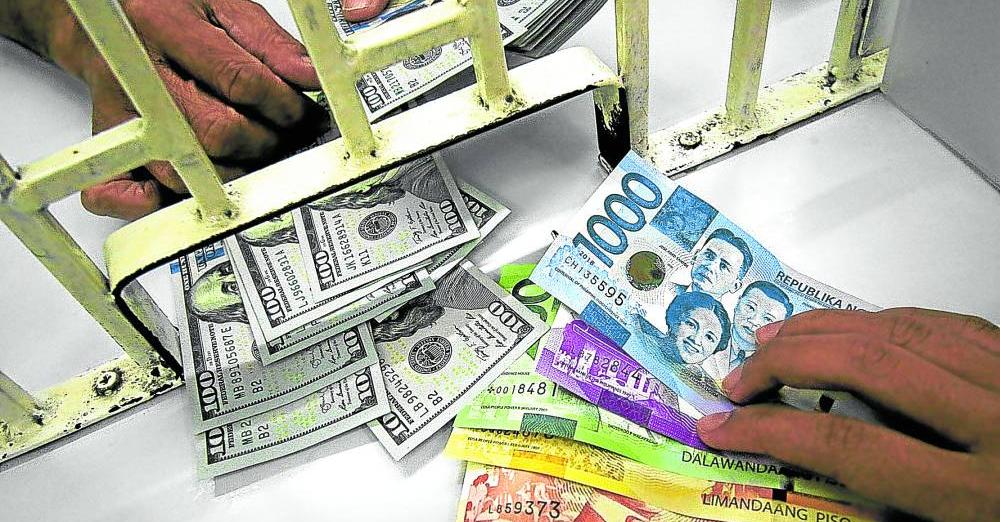Peso weakens to 20-month low of P58.80 to $1

Inquirer file photo
MANILA, Philippines — The Philippine peso dropped to a 20-month low at the end of a turbulent trading week, following a regional decline as the stronger US dollar impacted emerging market currencies.
The peso closed at 58.8 against the US dollar on Friday, two centavos lower than its previous close of 58.78.
Data showed this was the peso’s worst performance since closing at 58.87 per dollar on Oct. 24, 2022. On Friday, the local currency posted an intraday low of 58.88 while its best showing stood at 58.78.
At this point, the peso is now just a few centavos away from the record-low 59 posted in late 2022, when the Bangko Sentral ng Pilipinas (BSP) did not keep up with rising yields in the United States.
READ: Peso seen among Asia’s worst performers
Robert Dan Roces, chief economist at Security Bank, said the peso joined a regional downturn after the People’s Bank of China indicated a more relaxed stance on the yuan by setting its daily reference rate against the US dollar at the weakest level since November.
Such a move sparked speculation that China’s central bank is gradually allowing the yuan to weaken in the face of a rallying dollar. And Roces believed that the bearish sentiment spilled over to other emerging market currencies like the peso.
“This move has led to a dampened sentiment in regional foreign exchange markets, particularly in [emerging market] Asian [foreign exchange], where a softening bias was observed,” Roces said.
“It seems to have spilled over in [Friday’s] session too, [with the dollar strength] not helping,” he added.
Dovish BSP
The local unit had been trading at 19-month lows for most of June and had fallen by more than 5 percent so far this year.
While most market watchers blamed the peso’s volatility on hawkish signals from the US Federal Reserve—which is expected to delay its rate cuts amid stubbornly high inflation stateside—some observers said the local currency’s weakness could also be due to recent dovish remarks from some BSP officials.
BSP Governor Eli Remolona Jr. had said the central bank might start loosening its ultra-tight monetary policy settings in August by 25 basis points while penciling in another rate cut of the same size thereafter for a total of 50 bps reduction for the year.
Remolona also floated the possibility of the BSP cutting ahead of the Fed, as domestic inflation has remained within the central bank’s 2 percent to 4 percent target range so far this year.
READ: BSP unlikely to cut rates ahead of US Fed, says Nomura
Gov’t sees stronger peso this year
Figures showed inflation quickened to 3.9 percent in May from 3.8 percent in the previous month, which was not as bad as many analysts had expected.
At the same time, the BSP chief acknowledged that financial conditions were already tighter than necessary after data showed that economic growth in the first quarter was restrained by expensive borrowing costs.
For Leonardo Lanzona, an economist at Ateneo de Manila University, the dovish signals from the BSP were making things worse for the peso.
Conditions tighter than necessary
“I think the announcement that the BSP made regarding the possibility of reducing interest rate cuts caused this depreciation. As a result, the demand for the peso declined,” Lanzona said.
“The dollar value has strengthened, but the immediate effect of prospective lowered interest rates here even before the Fed reduces their US rates may seem to have caused a greater damage,” he added.
There are also some market watchers who pointed out that the BSP cannot cut ahead of the Fed.
This is because the peso may come under pressure if local yields become less attractive to capital inflows while interest rates are still high elsewhere, especially in the United States, which is considered a safe haven by investors. A sharp currency slump could risk fanning inflation by making imports more expensive.
But Remolona is so far unfazed by the peso’s weakness as he assured the public that the BSP has enough reserves, which amounted to $105 billion as of May, to pacify the peso.
John Paolo Rivera, president and chief economist at Oikonomia Advisory and Research Inc., believes the central bank has enough ammunition to defend the peso.
Disclaimer: The comments uploaded on this site do not necessarily represent or reflect the views of management and owner of Cebudailynews. We reserve the right to exclude comments that we deem to be inconsistent with our editorial standards.
